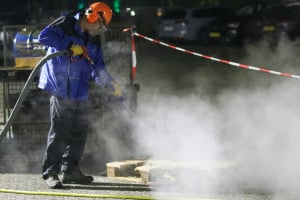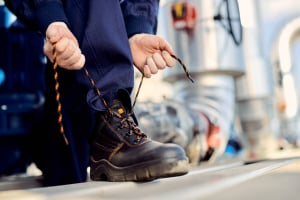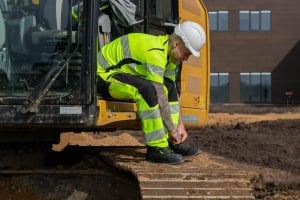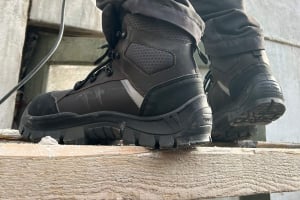
The construction sector: an economic pillar to secure
The construction sector is one of the largest French economic markets, worth nearly 310 billion euros and employing more than 150,000 employees across France. It is alsoone of the sectors most exposed to risks due to the very nature of its activity, which is why it is essential to insure those involved in this environment in the workplace . In this article, we will discover the different safety standards in construction, the necessary protective equipment and the laws that govern this gigantic sector.
Summary
The importance of safety standards in construction
A high-risk sector
The construction sector is recognized as one of the most dangerous working environments. Daily activities on a construction site such as working at height, moving large volumes of materials or even the use of hazardous energy such as electricity can lead to serious accidents.
Risk prevention
Over time, risk prevention has evolved significantly in France with the appearance of laws, safety standards in the construction industry and awareness of risks notably orchestrated by the Oppbtp (Professional Body for the Prevention of Building and Public Works). Thanks to increasingly rigorous procedures, monitored protocols and the appearance of ever more sophisticated tools, safety on construction sites has significantly improved.
A legal obligation
According to the Labor Code, the employer is obliged to take all necessary measures toensure safety and protect the physical and mental health of workers. This obligation covers a wide range of measures, ranging from the provision of personal protective equipment to the implementation of safety training.
Personal protective equipment (PPE): a necessity
Protection against various risks
As part of their activities, workers may be exposed to various risks that could harm their health, such as hearing, skin, respiratory problems, etc. PPE provides a protective barrier against these hazards, allowing workers to perform their tasks safely.
A regulatory obligation
Article R.233-83-3 of the Labor Code highlights the dangers that can threaten the safety or health of an individual at work. These regulatory texts recommend the wearing of PPE to prevent these risks. According to European Directive 89/686/EEC, PPE is defined as a means or device worn by a person to protect them against one or more of these risks.
Classification of PPE
Depending on the severity of the risks, there are three main categories of PPE:
-
- Category I: Protection against superficial attacks, such as vibrations, small shocks, and solar radiation.
- Category II: Protection against serious attacks, including those which may cause irreversible damage.
- Category III: Protection against fatal dangers, such as falls from height.
Diversity of EPs
There are a variety of PPE designed to protect different parts of the body. For example, head protection includes construction helmets, hard hats, and accessories. Other PPE includes eye, ear, face, hand, foot, and full body protection. Certain PPE, such as protective knee pads, safety caps, and safety boots, are particularly popular and sought after on the market.
Trend towards modernity
With technological evolution, PPE has also evolved to offer better protection while being aesthetically pleasing. PPE manufacturers, like those on Oxwork, offer innovative products that combine safety and modern design.
To conclude, PPE is essential to guarantee the safety of workers in construction. They provide essential protection against professional risks and are regulated by strict standards to ensure their effectiveness and reliability.
Standards and Equipment by Trade in Construction
In the construction sector, each profession has its own safety requirements and is subject to specific standards. Here are some examples illustrating how these standards and equipment are available according to the different trades.
The Masons
Masons are often exposed to risks of falling, contact with chemical substances and injuries due to the use of sharp tools. The different protective equipment for this profession meet standards such as:
- EN 397 for construction helmets
- EN 388 for abrasion resistant gloves
- EN ISO 20345 for safety shoes with non-slip soles
- EN 166 for splash protection glasses
Electricians
Electricians work with risks of exposure to high electrical voltages. For this reason, they must use specific PPE such as:
- EN 60903 for insulating gloves
- EN ISO 20345 SB for dielectric safety shoes
- EN 60900 for insulated tools
The NF C 18-510 and NF EN 50110-1 standards define the safety requirements for electrical work.
Building Painters
Painters face risks of inhalation of toxic vapors and contact with irritating chemicals. It is therefore essential for them to have the appropriate equipment including:
- EN 143 for masks with suitable filters
- EN 14605 for protective suits against chemicals
- EN 374 for chemical resistant gloves
The Roofers
Working mainly at height,roofers must protect themselves against the risk of falling. Recommended PPE includes:
- EN 361 for safety harnesses
- EN 795 for lifelines
- EN 397 for helmets with chin strap
The EN 361 and EN 397 standards are particularly relevant for the choice of fall arrest systems and safety helmets.
These examples are only an overview of the many specificities linked to each construction profession. It is crucial that each worker is equipped in accordance with the standards in force for their specific field of activity, in order to guarantee their safety and that of their colleagues on the site.
Collective protective equipment (EPC): an essential barrier
A first line of defense
Before even thinking about personal protective equipment (PPE), EPCs are the first line of defense against hazards on a construction site. They are designed to protect all workers present in a given area, thus reducing the risk of accidents.
Types of EPC commonly used in construction
-
- Guardrails: These barriers are installed around areas at risk of falling, such as roofs or elevated platforms. They prevent workers from accidentally falling.
- Safety nets: Installed under elevated work areas, they catch workers in the event of a fall, reducing the risk of serious injury.
- Scaffolding: These temporary structures provide a stable platform for working at height. They must be regularly inspected to ensure their safety.
Advantages of EPC
Universal Protection: Unlike PPE which depends on individual use, EPC protects all workers in an area, whether or not they are wearing PPE.
Risk reduction: By implementing collective protection measures, companies can significantly reduce the number of accidents on the construction site.
Regulatory Compliance: In many countries, the use of EPC is not only recommended, but also regulated by law. Their implementation therefore allows companies to comply with current security standards.
The importance of maintenance
Just like PPE, EPCs require regular maintenance. Structures such as scaffolding should be inspected regularly for signs of wear or damage. Safety nets, on the other hand, must be replaced if they show signs of damage.
Finally, EPCs play a vital role in the safety of construction sites. They provide collective protection which, combined with the appropriate use of PPE, creates a safe working environment for all workers.
In short, the construction sector, with its considerable economic weight and its inherent risks, requires particular attention to safety. The implementation of standards, the rigorous use of individual (PPE) and collective (EPC) protective equipment as well as compliance with regulations are fundamental pillars for guaranteeing the safety and health of workers in the construction sector.






